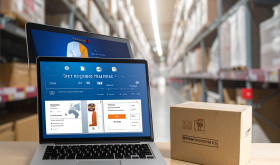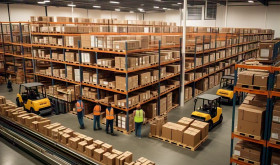
The retail sector faces a rocky economic scene marked by rising prices, unpredictable supply chains, worker shortages, and quick changes in what buyers want. These issues put pressure on profits, smooth operations, and keeping customers happy. In this climate, retailers are looking more and more to tech-driven answers, with warehouse management systems becoming a key tool. Among the most useful features of the new Warehouse Management System are demand forecasting and inventory optimisation, which help retailers match stock levels with market needs, cut costs, and boost their resilience.
The Economic Challenges Retailers Face
- Supply Chain Disruptions: Worldwide uncertainties, like political tensions and natural disasters, keep disrupting logistics. This causes late shipments and imbalanced stock levels.
- Inflation and Rising Costs: Higher prices for raw materials, shipping, and labours squeeze profit margins. This forces stores to cut down waste and optimise spending.
- Labour Shortages: Insufficient skilled warehouse workers make it hard to fill orders and manage inventory well.
- Volatile Consumer Demand: Economic uncertainty drives erratic purchasing behaviour, with sudden shifts in product preferences and spending habits.
- Cash Flow Constraints: Too much stock ties up money. Not having enough stuff leads to lost sales and unhappy customers.
These problems need agile, data-driven plans to balance stock efficiency with customer satisfaction—a balance that can be achieved through advanced Warehouse Management System features.
Demand Forecasting and Inventory Optimisation: The Warehouse Management System Game-Changer
At its heart, demand forecasting uses past sales info, market patterns, and smart computer algorithms to predict future product needs. Inventory optimisation makes sure stock matches these forecasts, cutting excess while avoiding shortages. When built into a warehouse management system, these tools allow retailers:
- Tweak reorder points and safety stock levels on their own.
- Spot slow-selling items and seasonal shifts.
- Put resources towards high-demand products.
- Match inventory across sales channels (like online and in-store).
By turning raw data into useful insights, retailers create a leaner, more responsive supply chain.
Addressing Economic Issues with Predictions of Demand and Stock Management
- Mitigating Supply Chain Disruptions
Supply chain uncertainty needs forward-thinking stock planning. Warehouse Management System-based demand predictions look at delivery times and supplier dependability, allowing retailers:
- To expect holdups: By spotting risks in supplier networks, the system recommends other sources or earlier restocking.
- To improve safety stock: AI tweaks backup stock as needed, making sure key items stay in stock during disruptions.
- To handle multi-level stock: Spread stock across warehouses to make supply chains local, cutting reliance on single points.
Example: A retailer dealing with port holdups uses warehouse management system insights to move stock to warehouses near the coast, making sure affected areas can restock faster.
- Fighting Inflation and Cost Pressures
Rising prices call for exact stock control. Warehouse management system optimisation tools to cut costs can:
- Cut down on excess stock: Having less extra inventory reduces storage fees and cuts markdowns on unsold goods.
- Speed up stock turnover: Matching stock to demand helps inventory move faster freeing up capital for key investments.
- Boost talks with suppliers: Forecasts based on data give an edge to get bulk discounts or flexible payment options.
Example: A grocery store chain uses demand predictions to cut waste of perishables by 30%, tackling food price hikes driven by inflation.
- Overcoming Labour Shortages
Automated inventory workflows decrease the need for manual labour. Warehouse Management System features include:
- Automated replenishment alerts: Start restocking tasks without manual oversight.
- Task prioritisation: Guide workers to crucial activities (like fulfilling urgent orders) when staff is limited.
- Integration with robotics: Link forecasting tools with automated guided vehicles (AGVs) to improve picking and packing.
Example: An electronics retailer uses AGVs guided by Warehouse Management System demand data, cutting labour hours by 25% in busy seasons.
- Adapting to Shifting Consumer Demand
Today’s shoppers switch between brands and product types. Real-time demand forecasting helps stores:
- Spot new trends: Combining social media and sales info helps find hot products.
- Quick stock changes: Order more of popular items and less of slow sellers.
- Smart Store Stocking: Put items in stores where they’ll sell best (like warm clothes in cold places).
Example: A clothing store uses trend analysis to stock up on eco-friendly apparel, catching a wave of buyers who want sustainable options.
- Boosting Cash Flow
Having the right amount of stock prevents capital from being locked in unsold goods. Warehouse management system tools help improve cash flow by:
- Cutting down stockouts: Making sure popular items stay in stock safeguards income flows.
- Getting rid of slow-sellers: Smart systems flag stagnant inventory for sales or returns.
- Matching supply and demand better: Accurate predictions help put funds into best-selling products.
Example: A home goods store cuts extra stock by 40%, redirecting $2M each year into growing its online and in-store presence.
Next Steps
To get the most out of demand forecasting and inventory management, stores need to:
- Invest in integrated warehouse management systems with AI capabilities.
- Teach staff how to understand and use data insights.
- Build stronger ties between suppliers, logistics partners, and sales channels.
As economic pressures persist, stores using these tools will become stronger, more trusted by customers, and more profitable.
In today’s uncertain economy, predicting demand and making the most of inventory in a warehouse management system gives retailers a way to stay afloat. This feature turns data into smart planning, tackling weak supply chains, rising costs, worker shortages, and changing demand. Stores that use these new ideas set themselves up not just to get by, but to succeed—changing tough times into chances to create new things and grow. The future belongs to stores that tap into the strength of smart inventory control.










